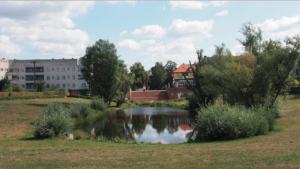In order to break-up what would otherwise have been a 14 hour long bus ride from Budapest to Warsaw, we decided to enjoy a day long intermission in the beautiful Czech city of Brno – the country’s second largest city. Al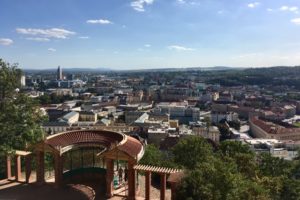 though, we could not find any luggage lockers in the city, which naturally affected the possible scope of our intended urban exploration, we still managed to see most of what the old town area had to offer, including the cabbage market, the Spilberk Castle and The Cathedral of St. Stephen and St. Paul. Considering the aim of this trip is not only to explore new cultures and cities across Europe but also represent Unesco world heritage, we felt it a be a pity if not chancing to visit the unesco protected functionalist Villa Tugendhat, which lies in a villa district east of city centre, behind Park Lužanky. Although we arrived too late to see th
though, we could not find any luggage lockers in the city, which naturally affected the possible scope of our intended urban exploration, we still managed to see most of what the old town area had to offer, including the cabbage market, the Spilberk Castle and The Cathedral of St. Stephen and St. Paul. Considering the aim of this trip is not only to explore new cultures and cities across Europe but also represent Unesco world heritage, we felt it a be a pity if not chancing to visit the unesco protected functionalist Villa Tugendhat, which lies in a villa district east of city centre, behind Park Lužanky. Although we arrived too late to see th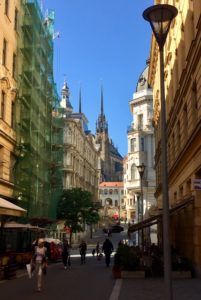 e interior of the building, the impression we got of the outside sufficed to support what Dr. Anke Zalivako had told us about it being a modern castle. As we waited for the bus to take us to Warsaw, we realised how much bigger Brno was than we had expected it to be and we regretted not having more time there as we would have loved to explore what lies in the outer districts of the city, such as the Veveri Castle, the Brno reservoir and the Moravian Karst.
e interior of the building, the impression we got of the outside sufficed to support what Dr. Anke Zalivako had told us about it being a modern castle. As we waited for the bus to take us to Warsaw, we realised how much bigger Brno was than we had expected it to be and we regretted not having more time there as we would have loved to explore what lies in the outer districts of the city, such as the Veveri Castle, the Brno reservoir and the Moravian Karst.
During our relatively short stay in Budapest, we tried to explore as much as possible of either side of the Danube, which splits the city into three principal districts: Buda, Pest and Obuda. Upon arrival, we walked through the northern city park which holds the iconic Széchenyi Fürdő (Thermal Baths) as well as the beautiful Vajdahunyad Castle.
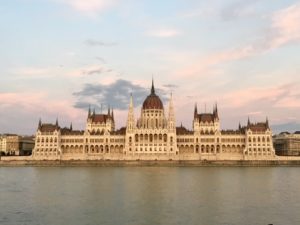
After dropping off our luggage we took a walk along the unesco world heritage listed Andrassy Utca, beneath which lies part of the second oldest metro system in the world.
Here we passed the famous House of Terror, which is dedicated to display parts of Hungarys history, with an emphasis on the fascist and communist regimes during the 20th-century. Later we saw the St. Stephens Basilica and after a traditional meal at the Retro Langos Bufet, circled the Dohány Street Synagogue – which is not only a magnificent structure in itself, but also the second largest synagogue in the world. The following day was dedicated more to exploring the Buda side of the city. As such, we begun with a climb from the Gellért Baths to the Liberty Monument, proudly crowning the top of Gellért Hill. With the citadella in our backs, we aimed ourselves in the direction of the Buda Castle where we enjoyed a great panoramic view of the pest side of the city, before continuing towards the Matthias church and the Fishermans Bastion. As dawn fell upon us, we eventually 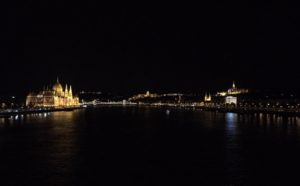 reached the Margaret island, whereupon we watched the mesmerising choreographies of the Musical fountain. Although we can proudly say our two days in Budapest were packed to the brim with urban exploration, we know there is still so much we didn’t get to see and as such, it is definitely a place we would like to revisit sometime in the future.
reached the Margaret island, whereupon we watched the mesmerising choreographies of the Musical fountain. Although we can proudly say our two days in Budapest were packed to the brim with urban exploration, we know there is still so much we didn’t get to see and as such, it is definitely a place we would like to revisit sometime in the future.
Upon arriving in Vienna, one need but a single glance to grasp the historical import of this impressive and beautiful metropolis, that rightfully claims an assortment of titles, such as the former capital of the Austrian-Hungarian Empire, the city of music and the birthplace of psychoanalysis.
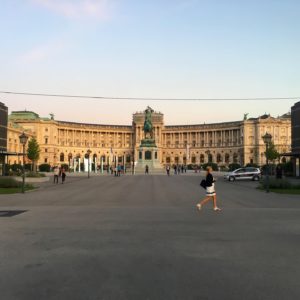
Navigating by foot, we often felt as if surrounded by a seemingly interminable myriad of grandiose buildings, ornate facades, decadent sculptures, lavish parks and intricate fountains and while both of us come from small cities, the singularly opulent Viennese city-scape, could not help but install
a novel sense of awe. With the Augarten in the north, the city center being comprised of the Wiener Staatoper, the Hofburg Palace – with its 16 adjacent complexes – the Museum Quarter, the St. Charles church and St. Stephens Cathedral, as well as the Albertina and the Secession Gallery, to the Schonbrunn Palace in the west and the Belevedere Palace in the east: Vienna is no doubt a testament to human achievement and the arts of architecture, infrastructure and city-planning alike.
In discovering Bavaria, doubtless one of the most iconic and idiosyncratic regions of Germany, that is often consid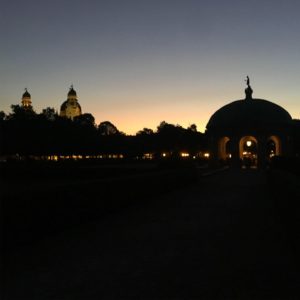 ered the heart of German culture, we begun by visiting Nuremberg – the second largest city in the Bavarian province and a former center in the holy Roman Empire. Beside once being home to the famous artist Albrecht Durer – whose house is today open for visitation – Nuremberg also housed more sinister guests during Hitlers Nazi Regime and was actively used as a muster point for massive military rallies as well as a germane backdrop for propaganda documentation. However, by the end of WWII, more than 90 percent of the city had been demolished thus the contemporary architectural palette is mainly comprised of new buildings and reconstructions designed to emulate medieval architecture. Despite still being an industrial powerhouse, Nuremberg has also become a popular tourist destination and between the imperial castle – which is surrounded by a myriad of timber framed houses, the impressive St.Lawrence church, the world famous toy museum and the incomparably Christmas spirit inducing Hauptmarkt, there is no wonder why the city attracts travellers from across the globe.
ered the heart of German culture, we begun by visiting Nuremberg – the second largest city in the Bavarian province and a former center in the holy Roman Empire. Beside once being home to the famous artist Albrecht Durer – whose house is today open for visitation – Nuremberg also housed more sinister guests during Hitlers Nazi Regime and was actively used as a muster point for massive military rallies as well as a germane backdrop for propaganda documentation. However, by the end of WWII, more than 90 percent of the city had been demolished thus the contemporary architectural palette is mainly comprised of new buildings and reconstructions designed to emulate medieval architecture. Despite still being an industrial powerhouse, Nuremberg has also become a popular tourist destination and between the imperial castle – which is surrounded by a myriad of timber framed houses, the impressive St.Lawrence church, the world famous toy museum and the incomparably Christmas spirit inducing Hauptmarkt, there is no wonder why the city attracts travellers from across the globe.
As our journey across Bavaria continued, it was only natural that Regensburg – once the capital of Bavaria – be our second destination. Like a pop-up book, the city’s history is vividly portrayed by the many monuments, edifices, natural resources and peculiarities that keep appearing around every new corner. The open remnants of a Roman fortress, dating back to 179 AD., speaks of the earlier stages of the city’s life, when it was but a strategic outpost for the holy Roman Empire, comprised of around 6000 soldiers. The numerous empty towers, which seemly serve no other function than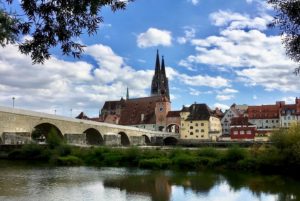 to try and outdo each others stature, relate to a time when the town had become a critical point in European trade and as such enjoyed wast economic growth. The great dom (st. Peters Church) that towers above all, which construction begun in 1275 and was completed in 1634 – with the exception of the towers that were raised in 1869 – indirectly narrates the city economic fluctuations, as well as its relation with the Catholic Church. While in Regensburg, we also met with Regional Secretariat, Monika Göttler who gave us a guided tour of the city before taking us to lunch at the oldest outdoors sausage kitchen in the world for a traditional meal. Monika also told us about her job and how in 2006 the old town of Regensburg got under the protection of unesco, as the only German medieval metropolis to remain intact post WWII. In modern days, Regensburg is home to several high tech companies such as BMW, Infineon and Osram, which make it one of the fastest growing cities in Germany, but it is also a popular tourist destination and with its high rated universities it also attracts students, which help the town remain young, vibrant and developing.
to try and outdo each others stature, relate to a time when the town had become a critical point in European trade and as such enjoyed wast economic growth. The great dom (st. Peters Church) that towers above all, which construction begun in 1275 and was completed in 1634 – with the exception of the towers that were raised in 1869 – indirectly narrates the city economic fluctuations, as well as its relation with the Catholic Church. While in Regensburg, we also met with Regional Secretariat, Monika Göttler who gave us a guided tour of the city before taking us to lunch at the oldest outdoors sausage kitchen in the world for a traditional meal. Monika also told us about her job and how in 2006 the old town of Regensburg got under the protection of unesco, as the only German medieval metropolis to remain intact post WWII. In modern days, Regensburg is home to several high tech companies such as BMW, Infineon and Osram, which make it one of the fastest growing cities in Germany, but it is also a popular tourist destination and with its high rated universities it also attracts students, which help the town remain young, vibrant and developing.
In concluding our campaign through Bavaria, the regional capital of Munich seemed a prudent choice. While there we accidentally stumbled upon the modern looking NS-Dokumentationszentrum, which houses an organised exhibition of Munich’s history with emphasis on its development during WWII and historical relation to semites. In comparison to most other educational institutions we visited along our Europe trip, we were impressed with its logical layout, professional presentation and free admission policy. We also paid a visit to the massive Pinakothekder moderne, which beside being a testament to architecture in itself, displayed works of Picasso, Beckmann, Bouyce, Laib, etc., as well as a great selection of seminal design objects, with an isolated section dedicated to the Bauhaus movement. As big as it is, while in Munich, we felt that it was a city for people. The streets were busy with life and tourism. In the evening we even observed an amateur class practicing waltz in a pavilion in the Hofgarten park. Had
We arrived but a couple weeks later to Munich, we wouldn’t have been able to secure accommodation due to the vastly popular Octoberfest, which is a city wide celebration of the Bavarian spirit. The city is also home to the second biggest football arena in Germany and as such attracts great number of football fans.
In summary, travelling through Bavaria has been an interesting experience and we leant a lot about their history. Both the positive and the negative aspects which are important when trying to understand why Germany is how it is today.
Upon arriving in Brussels we quickly realised exactly how important art, design and architecture is to the Brusseleers. With its g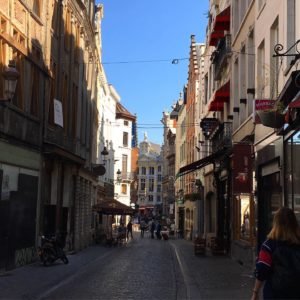 enerous assortment of public art, intriguing architecture and socially engaging urban spaces like Mont Des Arts, Brussels Park and Le Botanique, it is no wonder why the city has fostered so many talented and creative minds. Like Victor Horta, who is generally considered the father of the architectural styling of art nouveau. On our second day in Brussels we were fortunate to be granted audience with architect site manager for the Grand Place, Paula Cordeiro and general director of the urbanisation
enerous assortment of public art, intriguing architecture and socially engaging urban spaces like Mont Des Arts, Brussels Park and Le Botanique, it is no wonder why the city has fostered so many talented and creative minds. Like Victor Horta, who is generally considered the father of the architectural styling of art nouveau. On our second day in Brussels we were fortunate to be granted audience with architect site manager for the Grand Place, Paula Cordeiro and general director of the urbanisation
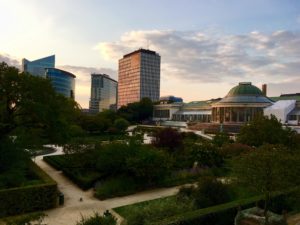
department in Brussels Michael Goetynck. They thought us a lot about the history of the Grand Place and the preservation processes that concerns the are before taking us on an exclusive tour up the 96 metre tall spire of the iconic Broodhuis. From there we could see most of
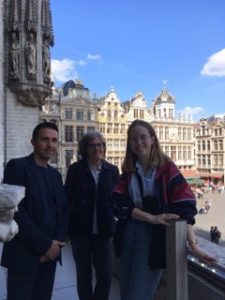
the city and it was easy for our hosts to share their knowledge, by pointing to various buildings, explaining their function and historical significance. Afterwards we were taken for lunch at the stylish BOZAR – a restaurant situated in one of the city’s most important cultural hubs, which also happens to be designed by the aforementioned Victor Horta.
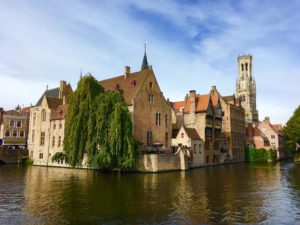 Entering Bruges felt almost like stepping into a real-life painting. It is by far the most picturesque city any of us have ever visited, with its cobblestoned streets, monumental churches, the chocolatiers crooked brick facades, the weeping willow trees lingering above waters, which mirror like surface is only occasionally broken by the currents of a swan.
Entering Bruges felt almost like stepping into a real-life painting. It is by far the most picturesque city any of us have ever visited, with its cobblestoned streets, monumental churches, the chocolatiers crooked brick facades, the weeping willow trees lingering above waters, which mirror like surface is only occasionally broken by the currents of a swan.
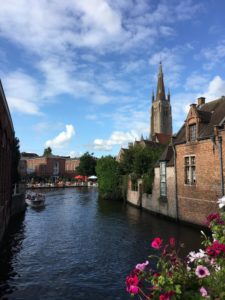 Crossing the streets you need seldom worry about passing cars but rather horse carriages and bikes. The air carries a sweet mixture of scents, from bakeries, confectioners, De Halve Maan brewery, and Belgian waffle parlors.
Crossing the streets you need seldom worry about passing cars but rather horse carriages and bikes. The air carries a sweet mixture of scents, from bakeries, confectioners, De Halve Maan brewery, and Belgian waffle parlors.
The historic center of Bruges which is under the protection of UNESCO world heritage, comprise of the famous belfry tower, burg square, basilica of the holy blood (where you can touch a vial supposed to contain Jesus Blood) the church of our lady (which is the second tallest medieval brick tower in the world), the intriguing Begijnhof (which local nuns still use as a cloister), Wijngaardplein and Minn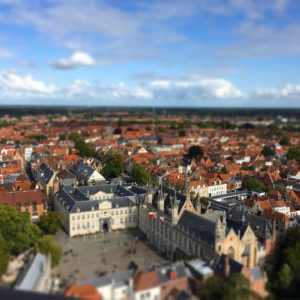 ewater which perennially inspire romantic aspirations.
ewater which perennially inspire romantic aspirations.
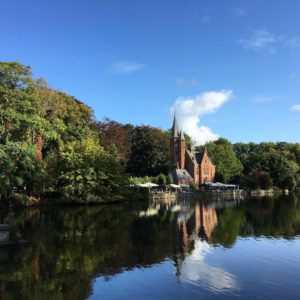 Bruges is historically significant for having been a nexus in northern economic trade. It was even a major trading post within the Hanseatic league. As is usually the case with economically strong cities with high fluctuations of external impressions, Bruges also became a centre for art in the Middle Ages, especially what is now referred as the Flemish primitives. Today the city still serves an important role fir Baltic and international trade, but is generally known as for being a tourist Mecca.
Bruges is historically significant for having been a nexus in northern economic trade. It was even a major trading post within the Hanseatic league. As is usually the case with economically strong cities with high fluctuations of external impressions, Bruges also became a centre for art in the Middle Ages, especially what is now referred as the Flemish primitives. Today the city still serves an important role fir Baltic and international trade, but is generally known as for being a tourist Mecca.
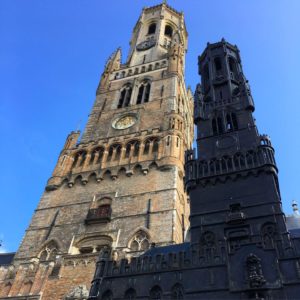
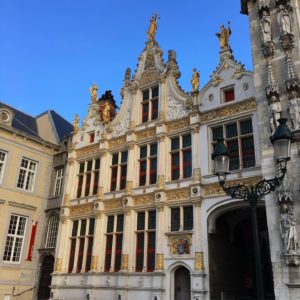
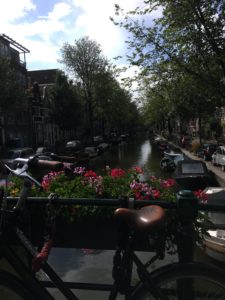 Amsterdam, capital of Netherlands, is one of the most iconic canal cities in the world. It is a city with rich history and was once one of the main economic trade points in seventeenth century Europe. As a leading economic force it was only natural that Amsterdam also became a hub for cultural development, especially during the era we now refer to as the Dutch Golden Age, which led to advancements in painting, architecture and technology. Perhaps particularly impressive was the advancements made within the field of hydraulic engineering, which the city is very much a testament of today. In modern times, the city has become a hot spot for tourism. It is unique in its libertarian views on recreational substances and continues to produce products like cheese and beer that is widely enjoyed across the globe.
Amsterdam, capital of Netherlands, is one of the most iconic canal cities in the world. It is a city with rich history and was once one of the main economic trade points in seventeenth century Europe. As a leading economic force it was only natural that Amsterdam also became a hub for cultural development, especially during the era we now refer to as the Dutch Golden Age, which led to advancements in painting, architecture and technology. Perhaps particularly impressive was the advancements made within the field of hydraulic engineering, which the city is very much a testament of today. In modern times, the city has become a hot spot for tourism. It is unique in its libertarian views on recreational substances and continues to produce products like cheese and beer that is widely enjoyed across the globe.
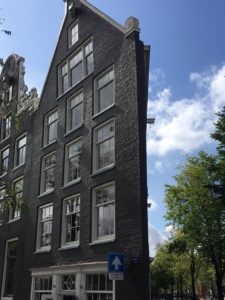
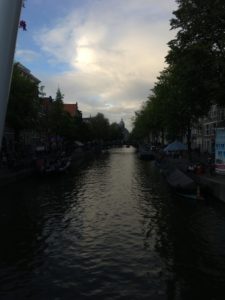
While visiting Amsterdam, we were quickly drawn toward the idiosyncratic architectural style and city planning, which due to now outdated utilitarian features, seemed almost lost in time. A good example is how almost every building still furnish hooks and pulleys to raise and lower cargo, despite there being virtually no need for such accessibility any longer. Though practically redundant these appendixes now pose a symbolic value and aptly reflect the city’s history as a naval-based center of commerce. Despite Amsterdam’s unique infrastructure clearly being designed to minister a different function, than the one its currently serving, it is still fascinating to see how the city council has benefited from this unique layout as well as the locals tailored lifestyles, favouring bikes over cars.
After two fully packed days in Amsterdam, we still felt as if we had barely scratched the surface of what the city had to offer. As we walked we sometimes abstained from conferring with the map, because there was simply no point in prioritising certain parts of the town over others. It is a city one could keep exploring ad infintum.
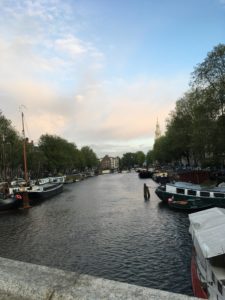
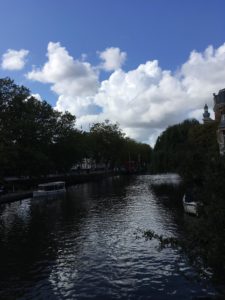
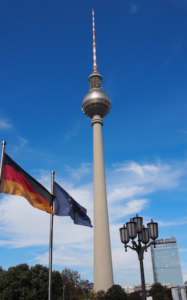
Wanting to discover and learn more about World Heritage Sites in Western and Central Europe within the context of urbanisation, architecture, society and culture we thought Berlin, with its rich history and multicultural atmosphere, a great place to begin our trip around Europe. While manoeuvring most of the city by foot and public transport, we got a first hand impression of Berlin’s broad spectrum of architectural styles which indirectly speaks to the city’s turbulent history.
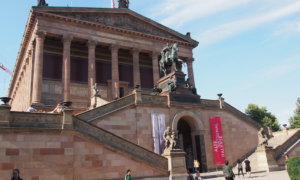
The mixture of neoclassical facades, Parisian building models, modern housing projects, grandiose structures and monumental edifices like the Berliner Fernsehturm speaks to Berlin’s many phases – from First, to Second World War and the division posed during the Cold War – and show how the denizens responded to periods of both adversity and prosperity.
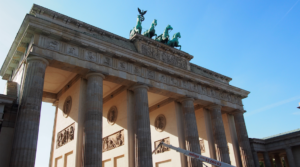
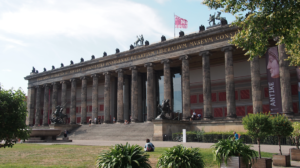 In light of Iga’s research, we organised a meeting with Dr.Anke Zalivako from Ladesdenkmalamt Berlin, who is responsible for the protection and preservation of major World Heritage SItes in Berlin such as: Museum Island, Palaces and Parks in Potsdam and Berlin and Six Berlin Modernism Housing Estates. The meeting was very insightful and Dr. Anke told us a lot
In light of Iga’s research, we organised a meeting with Dr.Anke Zalivako from Ladesdenkmalamt Berlin, who is responsible for the protection and preservation of major World Heritage SItes in Berlin such as: Museum Island, Palaces and Parks in Potsdam and Berlin and Six Berlin Modernism Housing Estates. The meeting was very insightful and Dr. Anke told us a lot
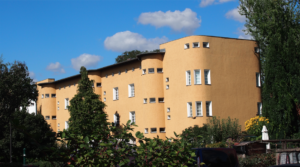 about the particular challenges that come with preserving World Heritage Sites. Perhaps especially interesting was it to learn more about the modern housing project and the difficulties that emerge in preserving something that is still in use by the public.
about the particular challenges that come with preserving World Heritage Sites. Perhaps especially interesting was it to learn more about the modern housing project and the difficulties that emerge in preserving something that is still in use by the public.
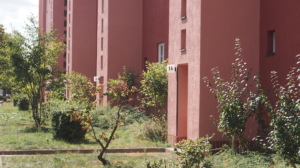
After the meeting with Dr. Zalivako, we begun to see the city in a different perspective as we now knew more about its architectural past and the changes particular neighbourhoods wen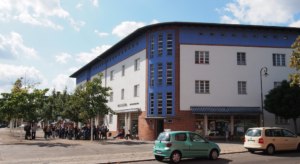 t through.
t through.
In curious pursuit of the Berlin Modernism Housing Estates we decided to see the Britz Residential Estate, which includes the Famous Horseshoe Estate. Although perhaps nothing special to a modern, its accolade as a UNESCO World Heritage Site is more than understandable. At the time of its inception in the 1920s, the Hufeisensiedlung was a highly innovative housing structure, meant to improve living conditions of lower income families by offering affordable, airy, sun-lit residencies,
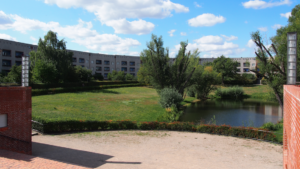 with individual kitchens, bathrooms and access to green spaces. The modern housing projects was also a shrewd move in tackling the housing shortage Berlin then suffered.
with individual kitchens, bathrooms and access to green spaces. The modern housing projects was also a shrewd move in tackling the housing shortage Berlin then suffered.
The idea of modern housing might have been too innovative to be fully appreciated in the 1920s. However adding Modern Estate Building of Berlin to World Heritage SItes list was an important decision as it is clear to see how much of an impact this way of making buildings has since had.
